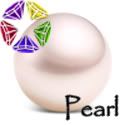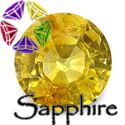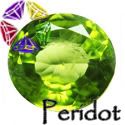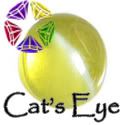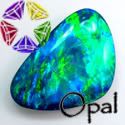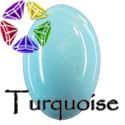
Labels
|

| Pearl | 9:14 AM |
|
|
|
Pearl
 Pearl is the traditional birthstone for the month of June. It is unique among the gemstone world as the only gem formed in a living creature. An old Arabian legend believed Pearls were formed when dew drops of moonlight fell into the ocean and were swallowed by oysters. Native American Indians have long used Pearls found in the Mississippi River in their necklaces, headdresses and copper ornaments.
Pearl is the traditional birthstone for the month of June. It is unique among the gemstone world as the only gem formed in a living creature. An old Arabian legend believed Pearls were formed when dew drops of moonlight fell into the ocean and were swallowed by oysters. Native American Indians have long used Pearls found in the Mississippi River in their necklaces, headdresses and copper ornaments.Pearl is also the astrological, Jyotish gem related to the Moon, which represents the psyche in man, ruling conscious and unconscious depths. It is associated with the mother and childhood and it rules peace of mind, comforts and the general well-being and fortune of a person. Wearing a pearl of at least 3 carats is said to bring fortune, recognition and fame to its wearer. It can be beneficial to any disease of the breast and brain. Pearl can be substituted with moonstone of at least 3-4 carats or more.
Gemological Properties
Color: The color of a pearl is the result of a body color and an overtone color (known as orient) present (due to surface effects) as a lustrous sheen. White, light cream, light rose, light yellow, blue and green overtones on a white body, black and colored pearls.
Hardness: 2.5-4.5
Density: 2.6-2.78; conch pearl, 2.85; cultured pearls, 2.72-2.78, i.e., heavier than most natural pearls, but this is not a diagnostic fact.
Occurrence: saltwater pearls are the most important on the market place. These come principally from the Persian gulf (coasts of Iran, Oman, Saudi Arabia and Bahrain State), Gulf of Manaar ( an arm of the Indian Ocean between India and Ceylon), Australia, South Seas, Japan, Venezuela. Freshwater pearls come from rivers throughout the world.
Astrological properties
Cosmic Color: Orange
Number: 2
Chakra: 10th, Svadtistana
Metal: Silver or white gold
Sign: Cancer
Element: Water
Day: Monday
Time: Evening
Sanskrit Names
Mukta (Pearl)Sasi-ratna (Gem of the moon)
Taraka (Falling star)
Jiva-ratna (Gem of the intellect)
Signs of a well-placed Moon
The native will have good affluence, good fortune, recognition and fame.
Emotions under control.
Good memory.
Balanced emotional life.
Prevention of the following diseases
Eye diseases, lunacy, paralysis, hysteria, epilepsy, cold, cough,
Colic pains, worms, intestinal disorders, tumors, peritonitis,
Throat troubles, asthma, bronchitis, varicose loins, nervous debility, cancer, typhoid
Birthstone for: June
The pearl is unique in the world of gemstones, as it is the only gemstone that is formed within a living creature. Known as the birthstone for the month of June, pearls are truly a treasured gift of the sea and revered for their colors, shapes, sizes and luster. As the supply of naturally occurring pearls became exhausted man learned how to cultivated them by implanting an irritant into oysters, which produced pearls having the same outer appearance as their natural counterpart. Cultured pearls are grown and harvested in many parts of the world, including the fresh waters of the Tennessee River, and are available in many beautiful colors, from the palest crème and white to rose, lilac, green, gold, gray and the dramatic Tahitian black. The majority, however, come from Japan, China and the South Pacific. Today, the pearls from the Japanese Akoyah oysters are becoming the most prized, as unfavorable biological and environmental conditions have reduced the availability of larger and finer quality pearls from the salt waters of Japan. Human innovation, however, has compensated for natures hardships as man has perfected the cultivation of the larger freshwater oysters in the lakes of China, producing an abundant crop of beautiful cultured pearls ranging from lustrous white to naturally occurring soft pastel colors.
To find beautiful pearls in much larger sizes, exceeding nine and ten millimeters in diameter, one must look to warm waters of the South Pacific where magnificent whites from Australia and dramatic natural blacks from Tahiti are harvested to produce one-of-a-kind necklaces or combined with diamonds for truly magnificent pieces of jewelry. In the cultivation process of all pearls man can only begin the process by implanting an irritant within the muscle of the oyster. After that it is up to the mollusk to produce a fine gem, a very poor gem, or something in-between. Similar to the way any gemstone is judged, the value of any pearl will depend on rarity, beauty, size, color, luster and degree of perfection. In the case of a strand of pearls, the quality of how well the pearls are matched is also an important consideration. In the world of pearls there is something for everyone.
Enhancements — Today, cultured and freshwater pearls are often bleached to achieve a uniform color. Sometimes they may be polished in tumblers to achieve better roundness and luster.
Order/Enquiry Form

© 2008 Allure Gems Collections
Redesign by DevilCp
Design by Templates4all
Converted to Blogger Template by BloggerTricks.com

